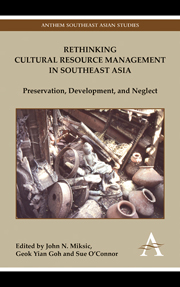Book contents
- Frontmatter
- Contents
- List of Tables and Figures
- Introduction: John N. Miksic
- Southeast Asia (General)
- East Timor
- Cambodia
- Chapter 5 Rethinking Cultural Resource Management: The Cambodian Case
- Chapter 6 Conservation of the Thnal Mrech Kiln Site, Anlong Thom, Phnom Kulen
- Chapter 7 Cultural Resource Management in Phnom Sruk: Potential and Problems
- Chapter 8 Archaeology and Cultural Resource Management South of Phnom Penh, Cambodia
- Chapter 9 Heritage Management of Wooden Prayer Halls in Battambang Province, Cambodia
- Myanmar
- The Philippines
- Singapore
- Vietnam
Chapter 8 - Archaeology and Cultural Resource Management South of Phnom Penh, Cambodia
from Cambodia
Published online by Cambridge University Press: 05 May 2012
- Frontmatter
- Contents
- List of Tables and Figures
- Introduction: John N. Miksic
- Southeast Asia (General)
- East Timor
- Cambodia
- Chapter 5 Rethinking Cultural Resource Management: The Cambodian Case
- Chapter 6 Conservation of the Thnal Mrech Kiln Site, Anlong Thom, Phnom Kulen
- Chapter 7 Cultural Resource Management in Phnom Sruk: Potential and Problems
- Chapter 8 Archaeology and Cultural Resource Management South of Phnom Penh, Cambodia
- Chapter 9 Heritage Management of Wooden Prayer Halls in Battambang Province, Cambodia
- Myanmar
- The Philippines
- Singapore
- Vietnam
Summary
Introduction
The lower Mekong archaeological sites of Cheung Ek and Sre Ampil, located on the outskirts of Phnom Penh, Cambodia possess good cultural resource management (CRM) potential. Their CRM potential extends well beyond normative archaeological research to include tourism, education, community development and involvement, and stakeholder identification and empowerment. Most importantly, the usage of the phrase CRM explicitly prioritizes proper management whether for preservation, pure research, educational endeavors (e.g. field schools, school tours, etc.), tourism promotion and development. Proper management is paramount and will benefit all stakeholders in many ways. Tradeoffs are expected and need to be carefully negotiated and accepted by all concerned stakeholders. These two sites constitute a backdrop to the consistent problems encountered in cultural resource management throughout Cambodia. This paper discusses these sites as unique phenomena and considers specific problems which exist at present. Additionally, it reviews general CRM issues throughout Cambodia, thus moving from specific to general issues throughout.
Both sites are vitally important for historical and archaeological research as well as tourism. Cheung Ek is popularly known as “the Killing Fields” because the Khmer Rouge disposed of victims in mass graves at particular locations in this site. Ironically, the mass graves were dug into an archaeological site containing vast amounts of pottery and might have included ancient burials. Few people understand that Cheung Ek also contains numerous archaeological remains suitable for addressing a broad spectrum of archaeological and historical questions in the larger context. Research and museum development will benefit local and international communities.
- Type
- Chapter
- Information
- Rethinking Cultural Resource Management in Southeast AsiaPreservation, Development, and Neglect, pp. 123 - 142Publisher: Anthem PressPrint publication year: 2011
- 1
- Cited by



